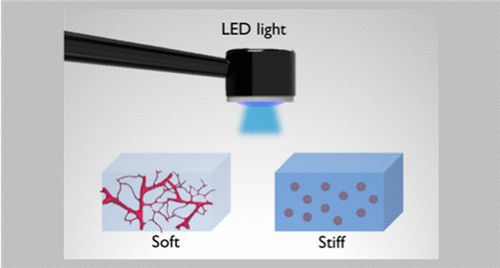当前位置:
X-MOL 学术
›
ACS Biomater. Sci. Eng.
›
论文详情
Our official English website, www.x-mol.net, welcomes your feedback! (Note: you will need to create a separate account there.)
Engineering Microvascular Networks in LED Light-Cured Cell-Laden Hydrogels
ACS Biomaterials Science & Engineering ( IF 5.8 ) Pub Date : 2018-06-08 00:00:00 , DOI: 10.1021/acsbiomaterials.8b00502 Nelson Monteiro 1 , Wenting He 1 , Cristiane Miranda Franca 1 , Avathamsa Athirasala 1 , Luiz E. Bertassoni 1
ACS Biomaterials Science & Engineering ( IF 5.8 ) Pub Date : 2018-06-08 00:00:00 , DOI: 10.1021/acsbiomaterials.8b00502 Nelson Monteiro 1 , Wenting He 1 , Cristiane Miranda Franca 1 , Avathamsa Athirasala 1 , Luiz E. Bertassoni 1
Affiliation

|
The success of tissue engineering inevitably depends on the fabrication of tissue constructs that can be vascularized and that anastomose with the host vasculature. In this report, we studied the effects of light-emitting diode (LED) photopolymerized gelatin methacryloyl hydrogels (GelMA), encapsulated with stem cells from the apical papilla (SCAP) and human umbilical vein endothelial cells (HUVECs), in promoting vasculature network formation as a function of hydrogel physical and mechanical properties, as well as total cell density. Lithium acylphosphinate (LAP) was used as the photoinitiator in concentrations of 0.05, 0.075, 0.1% (w/v). GelMA hydrogel precursors of 5% (w/v) were encapsulated with cocultures of SCAPs and HUVECs at different cell densities (1×, 5×, and 10 × 106 cells/mL) and photo-cross-linked for 5 s. Results suggested that the compressive modulus of GelMA hydrogels increased as a function of LAP concentration, and had a maximum stiffness of 3.2 kPa. GelMA hydrogels photopolymerized using 0.05 or 0.075% LAP, which had an average of 1.5 and 1.6 kPa of elastic modulus respectively, had the most efficient vasculature formation after 5 days, and these results were further enhanced when the highest cell density (10 × 106 cells/mL) was used. Immunofluorescence images showed that SCAP cells spread in close contact with endothelial networks and expressed alpha smooth muscle actin (αSMA), which is suggestive of their differentiation into pericyte-like cells. αSMA expression was also apparently higher in hydrogels polymerized with 0.05% LAP and 10 × 106 cells/mLl. In conclusion, photopolymerization of GelMA hydrogels using an LED-light source can be an effective method for potential chair-side/in situ procedures for engineering of vascularized tissue constructs in regenerative medicine.
中文翻译:

LED光固化的含细胞水凝胶中的工程微血管网络
组织工程学的成功不可避免地取决于制造可以被血管化并且与宿主脉管吻合的组织结构。在本报告中,我们研究了用顶端乳头(SCAP)和人脐静脉内皮细胞(HUVEC)的干细胞封装的发光二极管(LED)光聚合明胶甲基丙烯酸丙烯酰水凝胶(GelMA)在促进脉管系统网络形成中的作用与水凝胶的物理和机械性能以及总细胞密度有关。酰基次膦酸锂(LAP)以0.05、0.075、0.1%(w / v)的浓度用作光引发剂。5%(w / v)的GelMA水凝胶前体与SCAP和HUVEC的共培养物在不同细胞密度(1×,5×和10×10 6细胞/ mL)并光交联5 s。结果表明,GelMA水凝胶的压缩模量随LAP浓度的增加而增加,最大刚度为3.2 kPa。使用0.05或0.075%的LAP光聚合的GelMA水凝胶分别具有1.5和1.6 kPa的平均弹性模量,在5天后具有最有效的脉管系统形成,当细胞密度最高时(10×10 6),这些结果将进一步增强。细胞/ mL)。免疫荧光图像显示SCAP细胞在与内皮网络紧密接触的情况下扩散,并表达α平滑肌肌动蛋白(αSMA),这提示它们已分化为周细胞样细胞。在0.05%LAP和10×10 6聚合的水凝胶中,αSMA表达也明显更高。细胞/ mL。总之,使用LED光源进行GelMA水凝胶的光聚合可以成为潜在的椅旁/原位程序,用于再生医学中血管化组织构建物的工程设计。
更新日期:2018-06-08
中文翻译:

LED光固化的含细胞水凝胶中的工程微血管网络
组织工程学的成功不可避免地取决于制造可以被血管化并且与宿主脉管吻合的组织结构。在本报告中,我们研究了用顶端乳头(SCAP)和人脐静脉内皮细胞(HUVEC)的干细胞封装的发光二极管(LED)光聚合明胶甲基丙烯酸丙烯酰水凝胶(GelMA)在促进脉管系统网络形成中的作用与水凝胶的物理和机械性能以及总细胞密度有关。酰基次膦酸锂(LAP)以0.05、0.075、0.1%(w / v)的浓度用作光引发剂。5%(w / v)的GelMA水凝胶前体与SCAP和HUVEC的共培养物在不同细胞密度(1×,5×和10×10 6细胞/ mL)并光交联5 s。结果表明,GelMA水凝胶的压缩模量随LAP浓度的增加而增加,最大刚度为3.2 kPa。使用0.05或0.075%的LAP光聚合的GelMA水凝胶分别具有1.5和1.6 kPa的平均弹性模量,在5天后具有最有效的脉管系统形成,当细胞密度最高时(10×10 6),这些结果将进一步增强。细胞/ mL)。免疫荧光图像显示SCAP细胞在与内皮网络紧密接触的情况下扩散,并表达α平滑肌肌动蛋白(αSMA),这提示它们已分化为周细胞样细胞。在0.05%LAP和10×10 6聚合的水凝胶中,αSMA表达也明显更高。细胞/ mL。总之,使用LED光源进行GelMA水凝胶的光聚合可以成为潜在的椅旁/原位程序,用于再生医学中血管化组织构建物的工程设计。


























 京公网安备 11010802027423号
京公网安备 11010802027423号